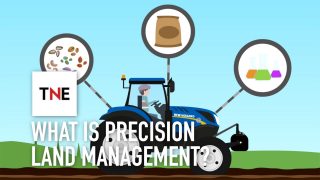
How big is wine’s carbon footprint, and how can technology reduce it?
In the third part of our agricultural innovation series, we explore sustainable viticulture
Show transcriptAt the end of a long day, when you sit down to relax with a glass of red, do you ever wonder about the impact the wine industry has on the climate? The glass bottle itself and international transport play a huge part, but big advances can be made by reducing emissions at the source – the vineyard. The New Economy looks at the impact that a sustainable viticulture programme can have on a vineyard’s carbon emissions, and exactly how much less carbon dioxide is released per bottle thanks to innovative technology.
Carbon dioxide emissions: governments are trying to reduce them, car makers sell themselves based on efficiency, and consumers look to organic and local produce for healthier, greener options. But at the end of a long day, when you sit down to relax with a glass of red, do you ever wonder about the impact the wine industry has on the climate?
Every bottle of wine accounts for around 1.2 kilograms of carbon dioxide released into our atmosphere.
It starts with grape production. Vineyards account for half the CO2 in every bottle of wine – with about half of this due to the machinery and fuel used in planting, growing and harvesting.
The other half of the bottle’s carbon is from the cellar and from retail. Bottling itself is responsible for a significant segment of this; and unless you live in California, Italy, or the south of France, so is getting the wine from the cellar to the shop.
Reducing the impact of food packaging and international transport are huge challenges that we don’t have time for here. Instead, let’s look at the source: where new, efficient vineyard technology can make a big difference.
Sustainable viticulture programmes, like New Holland Agriculture’s ECOBraud, combine equipment like Braud grape harvesters and specialty tractors with field mapping software and on board control systems to reduce wine’s environmental impact.
Tractors manufactured today can meet extremely challenging emissions standards. Today’s best machines produce just one percent of the carbon that machines built 20 years ago did.
Add to that an intelligent management system that automatically reduces fuel consumption: like optimising the grape harvester’s hydraulics and engine speed based on the machine’s actual load; or switching off the shaker system – the rods that shake the vines and knock grapes loose – when it reaches the end of a row. This intelligent management system alone can reduce fuel consumption by up to 31 percent.
Combine this with yield maps – which know exactly where fertiliser needs to be applied – and tractor software that can pinpoint that spot in the field to the centimetre: and you have a lean, green, efficient vineyard – low in waste, low in carbon, and low in costs.
It adds up to greater productivity and a much lower carbon footprint – reducing the amount of carbon emissions from vineyard machinery and fuel by up to 40 percent. That translates to a 10 percent reduction in the carbon footprint of each bottle of wine produced – meaning you can enjoy your glass with a clearer conscience.
Populations are growing; agricultural land is shrinking. Farmers are on the frontline.
Discover the technology that will help feed our future in Growing Smarter, our latest supplement feature, produced in association with New Holland Agriculture.

